Popular categories
Looking for a yarn?

75% Wool, 25% Polyamide
from 2.30 £ /50g
Order DROPS Fabel from Wool Warehouse Direct Ltd

|
DROPS Fabel uni colour 75% Wool, 25% Polyamide |
2.30 £ /50g |
Order |

|
DROPS Fabel 75% Wool, 25% Polyamide |
2.40 £ /50g |
Order |

|
DROPS Fabel long print 75% Wool, 25% Polyamide |
2.60 £ /50g |
Order |
Clicking the ORDER button will redirect you to Wool Warehouse Direct Ltd website
Order DROPS Brushed Alpaca Silk from Wool Warehouse Direct Ltd

|
DROPS Brushed Alpaca Silk uni colour 77% Alpaca, 23% Silk |
2.90 £ /25g |
Order |
Clicking the ORDER button will redirect you to Wool Warehouse Direct Ltd website
Order DROPS Needles & Hooks
Clicking the ORDER button will redirect you to Wool Warehouse Direct Ltd website
The yarn cost is calculated from the pattern’s smallest size and the yarn’s cheapest product type. Looking for an even better price? You might find it on the DROPS Deals!
Ash Valley Jacket
Knitted jacket in DROPS Fabel and DROPS Brushed Alpaca Silk. Piece is knitted top down with raglan and pockets. Size: S - XXXL
DROPS design: Pattern no FA-481
Yarn group A + C or D
----------------------------------------------------------
SIZE:
S - M - L - XL - XXL - XXXL
MATERIALS:
DROPS FABEL from Garnstudio (belongs to yarn group A)
250-300-300-350-350-400 g colour 651, sand
And use:
DROPS BRUSHED ALPACA SILK from Garnstudio (belongs to yarn group C)
175-175-200-225-225-250 g colour 04, light beige
DROPS BUTTON, Mocha NO 623: 6-6-7-7-7-7 pieces
NEEDLES:
DROPS CIRCULAR NEEDLE SIZE 5.5 mm : Length 40 and 80 cm.
DROPS CIRCULAR NEEDLE SIZE 4 mm: Length: 80 cm
DROPS DOUBLE POINTED NEEDLES SIZE 5.5 mm
DROPS DOUBLE POINTED NEEDLES SIZE 4 mm
The technique MAGIC LOOP can be used – you then only need circular needle of 80 cm in each size.
KNITTING TENSION:
15 stitches in width and 17 rows vertically in stocking stitch and 1 strand of each quality = 10 x 10 cm.
NOTE! Remember that needle size is only a suggestion. If you have too many stitches on 10 cm switch to larger needles. If you have too few stitches on 10 cm switch to smaller needles.
-------------------------------------------------------
Alternative Yarn – See how to change yarns here
Yarn Groups A to F – Use the same pattern and change the yarn here
Yarn usage using an alternative yarn – Use our yarn converter here
-------------------------------------------------------

75% Wool, 25% Polyamide
from 2.30 £ /50g
Order DROPS Fabel from Wool Warehouse Direct Ltd

|
DROPS Fabel uni colour 75% Wool, 25% Polyamide 2.30 £ /50g Order |

|
DROPS Fabel print 75% Wool, 25% Polyamide 2.40 £ /50g Order |

|
DROPS Fabel long print 75% Wool, 25% Polyamide 2.60 £ /50g Order |
Clicking the ORDER button will redirect you to Wool Warehouse Direct Ltd website
Order DROPS Fabel from Wool Warehouse Direct Ltd

|
DROPS Brushed Alpaca Silk uni colour 77% Alpaca, 23% Silk 2.90 £ /25g Order |
Clicking the ORDER button will redirect you to Wool Warehouse Direct Ltd website
Order DROPS Needles & Hooks
Clicking the ORDER button will redirect you to Wool Warehouse Direct Ltd website
The yarn cost is calculated from the pattern’s smallest size and the yarn’s cheapest product type. Looking for an even better price? You might find it on the DROPS Deals!
- English (UK/cm)
- Česky
- Dansk
- Deutsch
- Eesti keel - not translated
- English (US/in)
- Español
- Français
- Íslenska
- Italiano
- Magyar
- Nederlands
- Norsk
- Polski
- Português
- Suomi
- Svenska
- English (UK/cm), Bulgaria
- English (UK/cm), Croatia
- English (UK/cm), Greece
- English (UK/cm), Latvia
- English (UK/cm), Lithuania
- English (UK/cm), Romania
- English (UK/cm), Slovenia
- Česky, Slovakia
Pattern instructions
EXPLANATION FOR THE PATTERN:
----------------------------------------------------------
GARTER STITCH (back and forth):
Knit all rows.
1 ridge vertically = knit 2 rows.
PATTERN:
See diagram A.1. Diagrams show all rows in pattern seen from the right side.
INCREASE TIP (evenly):
To calculate how to increase evenly, use the total number of stitches on row (e.g. 79 stitches), minus bands (e.g. 10 stitches), and divide the remaining stitches by number of increases to be done (e.g. 3) = 23.
In this example increase by making 1 yarn over after approx. every 23rd stitch and do not increase over bands. On next row work yarn overs twisted to avoid holes.
RAGLAN:
All increases are done from the right side.
Increase 1 stitch on each side of stitch with marker in every transition between front/back piece and sleeves (= 8 stitches increased on row). Increase 1 stitch by making 1 yarn over. On next row purl yarn overs twisted to avoid holes. Then work the new stitches in stocking stitch.
DECREASE TIP (applies to mid under sleeves):
Decrease 1 stitch on each side of marker thread as follows: Work until 3 stitches remain before marker thread and knit 2 together, knit 2 (marker thread is between these 2 stitches), slip 1 stitch knitwise, knit 1, pass slipped stitch over stitch worked.
BUTTONHOLES:
Decrease for buttonholes on right band (when garment is worn). Decrease from right side when 3 stitches remain on row as follows: Make 1 yarn over, knit the next 2 stitches together, knit last stitch. On next row (wrong side) knit the yarn over to make a hole.
Decrease first buttonhole when rib in neck measures approx. 3 cm. Then decrease the next 5-5-6-6-6-6 buttonholes, approx. 9½-10-8½-9-9-9½ cm apart.
CAST-OFF TIP:
To avoid a tight cast-off edge when casting off, you may use a larger needle. If this still is too tight make 1 yarn over after approx. every 4th stitch while casting off (cast off yarn overs as stitches).
----------------------------------------------------------
START THE PIECE HERE:
----------------------------------------------------------
JACKET - SHORT OVERVIEW OF THE PIECE:
Work neck edge and yoke back and forth on circular needle from mid front, work top down. Now divide yoke for body and sleeves. Work body back and forth on circular needle, top down. Work sleeves in the round on double pointed needles/short circular needle, top down.
NECK EDGE:
Cast on 79-83-85-91-93-97 stitches on circular needle size 4 mm with 1 strand of each quality (= 2 strands). Purl 1 row (= wrong side). Then work rib as follows: 5 band stitches in GARTER STITCH - read explanation above - * knit 1, purl 1 *, work from *-* until 6 stitches remain, knit 1 and 5 band stitches in garter stitch. Continue back and forth like this until rib measures 3 cm. Decrease for BUTTONHOLES on right band - read explanation above.
Purl 1 row from wrong side (knit band stitches) while increasing 3-3-5-7-13-21 stitches evenly - read INCREASE TIP = 82-86-90-98-106-118 stitches.
Insert a marker after band at the beginning of row. NOW MEASURE PIECE FROM HERE!
YOKE:
Switch to circular needle size 5.5 mm.
Now insert 4 markers in the piece without working the as follows:
Skip the first 17-18-19-21-23-26 stitches, insert a marker in next stitch, skip the next 10 stitches, insert a marker in next stitch, skip the next 24-26-28-32-36-42 stitches, insert a marker in next stitch, skip the next 10 stitches, insert a marker in next stitch, 17-18-19-21-23-26 stitches remain after last stitch with marker.
Now work in stocking stitch with 5 band stitches in garter stitch in each side towards mid front, AT THE SAME TIME on first row from right side begin increase for RAGLAN – read explanation above. Increase like this every other row 17-19-20-22-24-26 times in total = 218-238-250-274-298-326 stitches.
Work until piece measures 20-22-24-26-28-30 cm from marker.
Now divide piece for body and sleeves as follows:
Work the first 34-37-39-43-47-52 stitches (= front piece), slip the next 46-50-52-56-60-64 stitches on a stitch holder for sleeve, cast on 8-10-10-10-10-10 new stitches on needle (= in the side under sleeve), work the next 58-64-68-76-84-94 stitches (= back piece), slip the next 46-50-52-56-60-64 stitches on a stitch holder for sleeve, cast on 8-10-10-10-10-10 new stitches on needle (= in the side under sleeve), work the last 34-37-39-43-47-52 stitches (= front piece).
Now finish body and sleeves separately. NOW MEASURE PIECE FROM HERE.
BODY:
= 142-158-166-182-198-218 stitches. Continue back and forth in stocking stitch with 5 band stitches in garter stitch in each side. When piece measures 15 cm in all sizes – adjust so that next row is worked from right side, work next row as follows:
Work the first 12-14-15-17-19-21 stitches as before, slip the next 21 stitches on a stitch holder for pocket, cast on 21 new stitches on needle, work the next 76-88-94-106-118-134 stitches, slip the next 21 stitches on a stitch holder for pocket, cast on 21 new stitches on needle and work the remaining 12-14-15-17-19-21 stitches as before = 142-158-166-182-198-218 stitches on needle.
Now work back and forth as before but over the 21 new stitches cast on for pocket, work pattern A.1.
When A.1 has been worked vertically, work in stocking stitch over all stitches with band stitches in each side as before.
When piece measures 29 cm, increase 15-15-17-19-19-21 stitches evenly (but not over the 5 band stitches in each side) = 157-173-183-201-217-239 stitches.
Switch to circular needle size 4 mm. Now work rib as follows (from right side): 5 band stitches in garter stitch. * Knit 1, purl 1 *, work from *-* until 6 stitches remain, knit 1, 5 band stitches in garter stitch. When rib measures 3 cm, cast off with knit over knit and purl over purl - read CAST-OFF TIP.
Jacket measures approx. 56-58-60-62-64-66 cm from shoulder and down.
POCKETS (the other half of pockets):
Slip the 21 stitches from one of the stitch holders back on needle size 5.5 mm and work in stocking stitch back and forth until pocket measures 10 cm. Cast off - make sure that the cast-off edge is not too tight. Fasten pocket to inside of jacket with invisible stitches. Work the other pocket the same way.
SLEEVES:
Slip the 46-50-52-56-60-64 stitches from stitch holder in one side on a short circular needle/double pointed needles size 5.5 mm. Pick in addition up 1 stitch in each of the 8-10-10-10-10-10 stitches cast on under sleeve = 54-60-62-66-70-74 stitches.
Insert a marker thread in the middle of the 8-10-10-10-10-10 stitches that were cast on under sleeves. Move markers upwards when working. Decrease on each side of marker thread. When sleeve measures 2 cm from division, decrease 1 stitch on each side of marker thread - read DECREASE TIP. Decrease like this approx. every 5-3-3-2-1½-1½ cm 3-5-5-7-8-9 times in total = 48-50-52-52-54-56 stitches. Continue until sleeve measures 40-38-37-35-33-32 cm from division (shorter measurements in the larger sizes because of wider neck and longer yoke). Knit 1 round while increasing 4-4-4-4-4-6 stitches evenly = 52-54-56-56-58-62 stitches. Switch to double pointed needles size 4 mm. Work rib (knit 1/purl 1) in the round for 4 cm. Cast off with knit over knit and purl over purl - remember CAST-OFF TIP.
Sleeve measures 44-42-41-39-37-36 cm in total from division.
Work the other sleeve the same way.
ASSEMBLY:
Sew the buttons on to left band.
Diagram

|
= knit from the right side, purl from the wrong side |

|
= purl from the right side, knit from the wrong side |

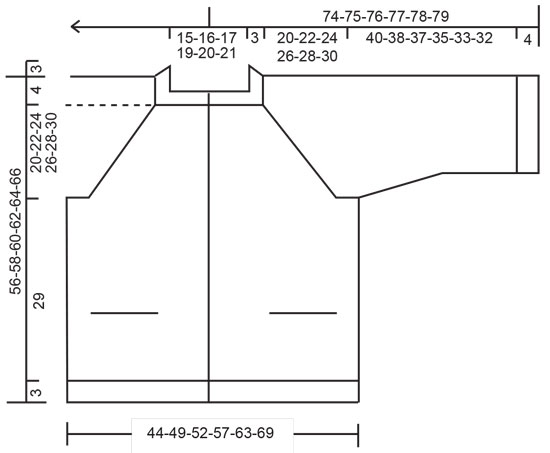
What can you do with our patterns? You can share DROPS patterns online, using the pattern original picture, materials, name and number. But you are NOT ALLOWED to reproduce the complete pattern digitally in any way. Yarn stores are welcome to use the DROPS pattern database to promote the sale of our assortment. You can print out our patterns, make as many copies as you’d like. The only thing we ask is that you don't make any changes / additions to the original printed document. And that the patterns according to the DROPS philosophy are given out to the consumers for free. Editorials that wish to publish our patterns in printed books or magazines can contact us for more information. The sale of garments based on DROPS patterns is permitted as long as they are sold as single items or per order. Further commercial use of the patterns is not permitted. It has to be clearly stated that the garment is made based on a design from DROPS DESIGN. The use of clothing labels of which DROPS DESIGN forms part is conditioned by the inclusion of the following text: “A DROPS DESIGN made by …..”. The use of DROPS photos for marketing purposes/sales is only permitted in connection with the use/sale of DROPS products. The photos may not be cut or edited and the logo should be clearly visible.
We reserve the right to withdraw the permission for use of our patterns at any time, notwithstanding the reason.
Each of our patterns has specific tutorial videos to help you.
These step-by-step tutorials might also help you:
Why is the knitting/crochet tension so important?
Knitting tension is what determines the final measurements of your work, and is usually measured per 10 x 10 cm. It is provided like so: number of stitches in width x number of rows in height - eg: 19 stitches x 26 rows = 10 x 10 cm.
The knitting tension is very individual; some people knit/crochet loosely while others work tightly. You adjust the knitting tension with the needle size, which is why the suggested needle size is only meant as a guide! You need to adjust this (up or down) to ensure that YOUR knitting tension matches the knitting tension provided in the pattern. If you work with a different knitting tension than provided you will have a different yarn consumption, and your work will have different measurements than what the pattern suggests.
The knitting tension also determines which yarns can replace each other. As long as you achieve the same knitting tension you can replace one yarn with another.
See DROPS lesson: How to measure your tension/gauge
See DROPS video: How to make a gauge tension swatch
How do I know how many balls of yarn I need?
The required amount of yarn is provided in grams, eg: 450 g. To calculate how many balls you’ll need you first need to know how many grams are in 1 ball (25g, 50g or 100g). This information is available if you click on the individual yarn quality on our pages. Divide the amount required with the amount of each ball. For example, if each ball is 50g (the most common amount), the calculation will be as follows: 450 / 50 = 9 balls.
Can I use a different yarn than what the pattern suggests?
The important thing when changing from one yarn to another is that the knitting/crochet tension remains the same. This is so that the measurements of the finished piece will be the same as on the sketch provided. It is easier to achieve the same knitting tension using yarns from the same yarn group. It is also possible to work with multiple strands of a thinner yarn to achieve the knitting tension of a thicker one. Please try our yarn converter. We recommend you to always work a test swatch.
Please NOTE: when changing yarn the garment might have a different look and feel to the garment in the photo, due to individual properties and qualities of each yarn.
See DROPS lesson: Can I use a different yarn than the one mentioned in the pattern?
What are the yarn groups?
All our yarns are categorised into yarn groups (from A to F) according to thickness and knitting tension – group A contains the thinnest yarns and group F the thickest. This makes it easier for you to find alternative yarns to our patterns, should you wish to switch yarn. All yarns within the same group have a similar knitting tension and can easily replace each other. However, different yarn qualities have different structures and properties which will give the finished work a unique look and feel.
How do I use the yarn calculator?
At the top of all our patterns you’ll find a link to our yarn calculator, which is a helpful tool should you wish to use a different yarn than suggested. By filling in the yarn quality you wish to replace, the amount (in your size) and number of strands, the calculator will present good alternative yarns with the same knitting tension. Additionally it will tell you how much you’ll require in the new qualities and whether you’ll need to work with multiple strands. Most skeins are 50g (some are 25g or 100g).
If the pattern is worked with multiple colours, every colour will have to be calculated separately. Similarly, if the pattern is worked with several strands of different yarns (for example 1 strand Alpaca and 1 strand Kid-Silk) you will have to find alternatives for each, individually.
Why do you show discontinued yarns in the patterns?
Since different yarns have different qualities and textures we have chosen to keep the original yarn in our patterns. However, you can easily find options among our available qualities by using our yarn calculator, or simply pick a yarn from the same yarn group.
It is possible that some retailers still have discontinued yarns in stock, or that someone has a few skeins at home that they would like to find patterns for.
The yarn calculator will provide both alternative yarn as well as required amount in the new quality.
What size should I knit?
If you think it's hard to decide what size to make, it can be a good idea to measure a garment you own already and like the size of. Then you can pick the size by comparing those measures with the ones available in the pattern's size chart.
You'll find the size chart at the bottom of the pattern.
See DROPS lesson: How to read size chart
Why do I get the wrong knitting tension with the suggested needle size?
The needle size provided in the pattern serves only as a guide, the important thing is to follow the knitting tension. And since knitting tension is very individual, you will have to adjust the needle size to ensure that YOUR tension is the same as in the pattern – maybe you’ll have to adjust 1, or even 2 needle sizes, up or down to achieve the correct tension. For this, we recommend that you work test swatches.
Should you work with a different knitting tension than the one provided, the measurements of the finished garment might deviate from the measurement sketch.
See DROPS lesson: How to measure your tension/gauge
See DROPS video: How to make a tension/gauge swatch
Why is the pattern worked top-down?
Working a garment top-down provides more flexibility and room for personal adjustment. For example it is easier to try the garment on while working, as well as making adjustments to length of yoke and shoulder caps.
The instructions are carefully explaining every step, in the correct order. Diagrams are adjusted to the knitting direction and are worked as usual.
How do I work according to a knitting diagram?
The diagram depicts all rows/rounds, and every stitch seen from the right side. It is read from bottom to top, from right to left. 1 square = 1 stitch.
When working back and forth, every other row is worked from the right side and every other row is worked from the wrong side. When working from the wrong side, the diagram will have to be worked reversed: from left to right, knit stitches are purled, purl stitches are knit etc.
When working in the round every round is worked from the right side and the diagram are worked from right to left on all rounds.
See DROPS lesson: How to read knitting diagrams
How do I work according to a crochet diagram?
The diagram depicts all rows/rounds, and every stitch seen from the right side. It is worked from bottom to top, from right to left.
When working back and forth every other row is worked from the right side: from right to left and every other row is worked from the wrong side: from left to right.
When working in the round, every row in the diagram are worked from the right side, from right to left.
When working a circular diagram you start in the middle and work your way outwards, counter clockwise, row by row.
The rows usually start with a given number of chain stitches (equivalent to the height of the following stitch), this will either be depicted in the diagram or explained in the pattern.
See DROPS lesson: How to read crochet diagrams
How do I work several diagrams simultaneously on the same row/round?
Instructions for working several diagrams after each other on the same row/round, will often be written like so: “work A.1, A.2, A.3 a total of 0-0-2-3-4 times". This means you work A.1 once, then A.2 is worked once, and A.3 is repeated (in width) the number of times provided for your size – in this case like so: S = 0 times, M = 0 times, L=2 times, XL= 3 times and XXL = 4 times.
The diagrams are worked as usual: begin with the first row in A.1, then work the first row in A.2 etc.
See DROPS lesson: How to read knitting diagrams
See DROPS lesson: How to read crochet diagrams
Why are the sleeves shorter in larger sizes?
The total width of the garment (from wrist-to-wrist) will be larger in the larger sizes, despite the actual sleeves being shorter. The larger sizes have longer sleeve caps and wider shoulders, so there will be a good fit in all sizes.
Where on the garment is the length measured?
The measurement sketch/schematic drawing provides information regarding the full length of the garment. If it’s a jumper or a jacket the length is measured from the highest point on the shoulder closest to the neckline, and straight down to the bottom of the garment. It is NOT measured from the tip of shoulder. Similarly, the length of yoke is measured from the highest point on the shoulder and down to where yoke is split into body and sleeves.
On a jacket measures are never taken along bands, unless specifically stated. Always measure inside band stitches when measuring the length.
See DROPS lesson: How to read a schematic drawing
What is a repeat?
Diagrams are often repeated on the round or in height. 1 repeat is the diagram the way it appears in the pattern. If it says to work 5 repeats of A.1 in the round, then you work A.1 a total of 5 times after/next to each other in the round. If it says to work 2 repeats of A.1 vertically/in height you work the entire diagram once, then begin again at the start and work the entire diagram one more time.
Why does the piece start with more chain stitches than it’s worked with?
Chain stitches are slightly narrower than other stitches and to avoid working the cast-on edge too tight, we simply chain more stitches to begin with. The stitch count will be adjusted on the following row to fit the pattern and measurement sketch.
Why increase before the rib edge when the piece is worked top-down?
The rib edge is more elastic and will contract slightly compared to, for example, stocking stitch. By increasing before the rib edge, you avoid a visible difference in width between the rib edge and the rest of the body.
Why increase in the cast-off edge?
It’s very easy to cast off too tightly, and by making yarn overs while casting off (and simultaneously casting these off) you avoid a too tight cast off edge.
See DROPS video: How to bind off with yarn overs (yo)
How do I increase/decrease on every 3rd and 4th row/round alternately?
To achieve an even increase (or decrease) you can increase on, for example: every 3rd and 4th row alternately, like so: work 2 rows and increase on the 3rd row, work 3 rows and increase on the 4th. Repeat this until the increase is complete.
See DROPS lesson: Increase or decrease 1 st on every 3rd and 4th row alternately
How can I work a jacket in the round instead of back and forth?
Should you prefer to work in the round instead of back and forth, you may of course adjust the pattern. You’ll need to add steeks mid-front (usually 5 stitches), and follow the instructions. When you would normally turn and work from the wrong side, simply work across the steek and continue in the round. At the end you’ll cut the piece open, pick up stitches to work bands, and cover the cut edges.
See DROPS video: How to knit steeks and cut open
Can I work a jumper back and forth instead of in the round?
Should you prefer to work back and forth instead of in the round, you may of course adjust the pattern so you work the pieces separately and then assemble them at the end. Divide the stitches for the body in 2, add 1 edge stitch in each side (for sewing) and work the front and back pieces separately.
See DROPS lesson: Can I adapt a pattern for circular needles into straight needles?
Why is the pattern slightly different than what I see in the photo?
Pattern repeats can vary slightly in the different sizes, in order to get the correct proportions. If you’re not working the exact same size as the garment in the photo, yours might deviate slightly. This has been carefully developed and adjusted so that the complete impression of the garment is the same in all sizes.
Make sure to follow instructions and diagrams for your size!
How do I make a women’s size garment into a men’s size one?
If you have found a pattern you like which is available in women’s size it’s not very difficult to convert it to men’s size. The biggest difference will be the length of sleeves and body. Start working on the women size that you think would fit across the chest. The additional length will be worked right before you cast off for the armhole/sleeve cap. If the pattern is worked top-down you can add the length right after the armhole or before the first decrease on sleeve.
Regarding additional yarn amount, this will depend on how much length you add, but it is better with a skein too many than too few.
How do I prevent a hairy garment from shedding?
All yarns will have excess fibres (from production) that might come off as lint or shedding. Brushed yarns (ie hairier yarns) have more of these loose, excess fibres, causing more shedding.
Shedding also depends on what is worn under or over the garment, and whether this pulls at the yarn fibres. It’s therefore not possible to guarantee that there will be no shedding
Below are some tips on how to get the best result when working with hairier yarns:
1. When the garment is finished (before you wash it) shake it vigorously so the looser hairs come off. NOTE: do NOT use a lint roller, brush or any method that pulls at the yarn.
2. Place the garment in a plastic bag and put it in your freezer - the temperature will cause the fibres to become less attached to each other, and excess fibres will come off easier.
3. Leave in the freezer for a few hours before taking it out and shaking it again.
4. Wash the garment according to the instructions on the yarn label.
Why does my garment pill?
Pilling is a natural process that happens to even the most exclusive of fibers. It's a natural sign of wear and tear that is hard to avoid, and that is most visible in high friction areas of your garment like a sweater's arms and cuffs.
You can make your garment look as new by removing the pilling, using a fabric comb or a pill/lint remover.
In the meantime, you can read the questions and answers that others have left to this pattern or join the DROPS Workshop on Facebook to get help from fellow knitters/crocheters!
You might also like...
Ash Valley Jacket |
|||||||
 |
 |
||||||
Knitted jacket in DROPS Fabel and DROPS Brushed Alpaca Silk. Piece is knitted top down with raglan and pockets. Size: S - XXXL
DROPS 226-18 |
|||||||
|
---------------------------------------------------------- EXPLANATION FOR THE PATTERN: ---------------------------------------------------------- GARTER STITCH (back and forth): Knit all rows. 1 ridge vertically = knit 2 rows. PATTERN: See diagram A.1. Diagrams show all rows in pattern seen from the right side. INCREASE TIP (evenly): To calculate how to increase evenly, use the total number of stitches on row (e.g. 79 stitches), minus bands (e.g. 10 stitches), and divide the remaining stitches by number of increases to be done (e.g. 3) = 23. In this example increase by making 1 yarn over after approx. every 23rd stitch and do not increase over bands. On next row work yarn overs twisted to avoid holes. RAGLAN: All increases are done from the right side. Increase 1 stitch on each side of stitch with marker in every transition between front/back piece and sleeves (= 8 stitches increased on row). Increase 1 stitch by making 1 yarn over. On next row purl yarn overs twisted to avoid holes. Then work the new stitches in stocking stitch. DECREASE TIP (applies to mid under sleeves): Decrease 1 stitch on each side of marker thread as follows: Work until 3 stitches remain before marker thread and knit 2 together, knit 2 (marker thread is between these 2 stitches), slip 1 stitch knitwise, knit 1, pass slipped stitch over stitch worked. BUTTONHOLES: Decrease for buttonholes on right band (when garment is worn). Decrease from right side when 3 stitches remain on row as follows: Make 1 yarn over, knit the next 2 stitches together, knit last stitch. On next row (wrong side) knit the yarn over to make a hole. Decrease first buttonhole when rib in neck measures approx. 3 cm. Then decrease the next 5-5-6-6-6-6 buttonholes, approx. 9½-10-8½-9-9-9½ cm apart. CAST-OFF TIP: To avoid a tight cast-off edge when casting off, you may use a larger needle. If this still is too tight make 1 yarn over after approx. every 4th stitch while casting off (cast off yarn overs as stitches). ---------------------------------------------------------- START THE PIECE HERE: ---------------------------------------------------------- JACKET - SHORT OVERVIEW OF THE PIECE: Work neck edge and yoke back and forth on circular needle from mid front, work top down. Now divide yoke for body and sleeves. Work body back and forth on circular needle, top down. Work sleeves in the round on double pointed needles/short circular needle, top down. NECK EDGE: Cast on 79-83-85-91-93-97 stitches on circular needle size 4 mm with 1 strand of each quality (= 2 strands). Purl 1 row (= wrong side). Then work rib as follows: 5 band stitches in GARTER STITCH - read explanation above - * knit 1, purl 1 *, work from *-* until 6 stitches remain, knit 1 and 5 band stitches in garter stitch. Continue back and forth like this until rib measures 3 cm. Decrease for BUTTONHOLES on right band - read explanation above. Purl 1 row from wrong side (knit band stitches) while increasing 3-3-5-7-13-21 stitches evenly - read INCREASE TIP = 82-86-90-98-106-118 stitches. Insert a marker after band at the beginning of row. NOW MEASURE PIECE FROM HERE! YOKE: Switch to circular needle size 5.5 mm. Now insert 4 markers in the piece without working the as follows: Skip the first 17-18-19-21-23-26 stitches, insert a marker in next stitch, skip the next 10 stitches, insert a marker in next stitch, skip the next 24-26-28-32-36-42 stitches, insert a marker in next stitch, skip the next 10 stitches, insert a marker in next stitch, 17-18-19-21-23-26 stitches remain after last stitch with marker. Now work in stocking stitch with 5 band stitches in garter stitch in each side towards mid front, AT THE SAME TIME on first row from right side begin increase for RAGLAN – read explanation above. Increase like this every other row 17-19-20-22-24-26 times in total = 218-238-250-274-298-326 stitches. Work until piece measures 20-22-24-26-28-30 cm from marker. Now divide piece for body and sleeves as follows: Work the first 34-37-39-43-47-52 stitches (= front piece), slip the next 46-50-52-56-60-64 stitches on a stitch holder for sleeve, cast on 8-10-10-10-10-10 new stitches on needle (= in the side under sleeve), work the next 58-64-68-76-84-94 stitches (= back piece), slip the next 46-50-52-56-60-64 stitches on a stitch holder for sleeve, cast on 8-10-10-10-10-10 new stitches on needle (= in the side under sleeve), work the last 34-37-39-43-47-52 stitches (= front piece). Now finish body and sleeves separately. NOW MEASURE PIECE FROM HERE. BODY: = 142-158-166-182-198-218 stitches. Continue back and forth in stocking stitch with 5 band stitches in garter stitch in each side. When piece measures 15 cm in all sizes – adjust so that next row is worked from right side, work next row as follows: Work the first 12-14-15-17-19-21 stitches as before, slip the next 21 stitches on a stitch holder for pocket, cast on 21 new stitches on needle, work the next 76-88-94-106-118-134 stitches, slip the next 21 stitches on a stitch holder for pocket, cast on 21 new stitches on needle and work the remaining 12-14-15-17-19-21 stitches as before = 142-158-166-182-198-218 stitches on needle. Now work back and forth as before but over the 21 new stitches cast on for pocket, work pattern A.1. When A.1 has been worked vertically, work in stocking stitch over all stitches with band stitches in each side as before. When piece measures 29 cm, increase 15-15-17-19-19-21 stitches evenly (but not over the 5 band stitches in each side) = 157-173-183-201-217-239 stitches. Switch to circular needle size 4 mm. Now work rib as follows (from right side): 5 band stitches in garter stitch. * Knit 1, purl 1 *, work from *-* until 6 stitches remain, knit 1, 5 band stitches in garter stitch. When rib measures 3 cm, cast off with knit over knit and purl over purl - read CAST-OFF TIP. Jacket measures approx. 56-58-60-62-64-66 cm from shoulder and down. POCKETS (the other half of pockets): Slip the 21 stitches from one of the stitch holders back on needle size 5.5 mm and work in stocking stitch back and forth until pocket measures 10 cm. Cast off - make sure that the cast-off edge is not too tight. Fasten pocket to inside of jacket with invisible stitches. Work the other pocket the same way. SLEEVES: Slip the 46-50-52-56-60-64 stitches from stitch holder in one side on a short circular needle/double pointed needles size 5.5 mm. Pick in addition up 1 stitch in each of the 8-10-10-10-10-10 stitches cast on under sleeve = 54-60-62-66-70-74 stitches. Insert a marker thread in the middle of the 8-10-10-10-10-10 stitches that were cast on under sleeves. Move markers upwards when working. Decrease on each side of marker thread. When sleeve measures 2 cm from division, decrease 1 stitch on each side of marker thread - read DECREASE TIP. Decrease like this approx. every 5-3-3-2-1½-1½ cm 3-5-5-7-8-9 times in total = 48-50-52-52-54-56 stitches. Continue until sleeve measures 40-38-37-35-33-32 cm from division (shorter measurements in the larger sizes because of wider neck and longer yoke). Knit 1 round while increasing 4-4-4-4-4-6 stitches evenly = 52-54-56-56-58-62 stitches. Switch to double pointed needles size 4 mm. Work rib (knit 1/purl 1) in the round for 4 cm. Cast off with knit over knit and purl over purl - remember CAST-OFF TIP. Sleeve measures 44-42-41-39-37-36 cm in total from division. Work the other sleeve the same way. ASSEMBLY: Sew the buttons on to left band. |
|||||||
Diagram explanations |
|||||||
|
|||||||

|
|||||||

|
|||||||
|
Have you made this or any other of our designs? Tag your pictures in social media with #dropsdesign so we can see them! Do you need help with this pattern?You'll find tutorial videos, a Comments/Questions area and more by visiting the pattern on garnstudio.com. © 1982-2024 DROPS Design A/S. We reserve all rights. This document, including all its sub-sections, has copyrights. Read more about what you can do with our patterns at the bottom of each pattern on our site. |
|||||||
With over 40 years in knitting and crochet design, DROPS Design offers one of the most extensive collections of free patterns on the internet - translated to 17 languages. As of today we count 304 catalogues and 11422 patterns - 11422 of which are translated into English (UK/cm).
We work hard to bring you the best knitting and crochet have to offer, inspiration and advice as well as great quality yarns at incredible prices! Would you like to use our patterns for other than personal use? You can read what you are allowed to do in the Copyright text at the bottom of all our patterns. Happy crafting!







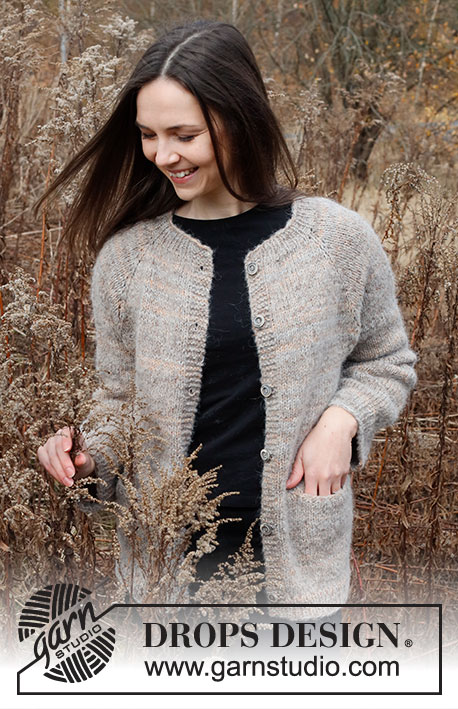
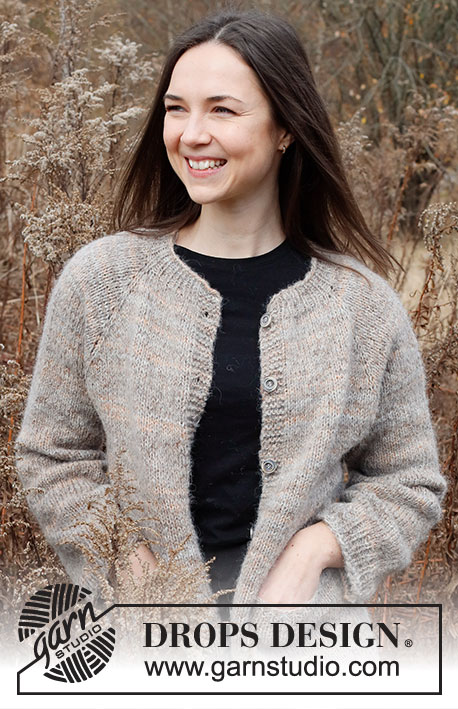


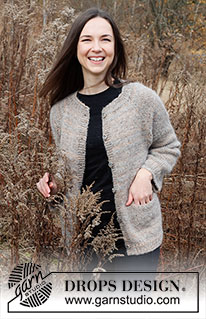
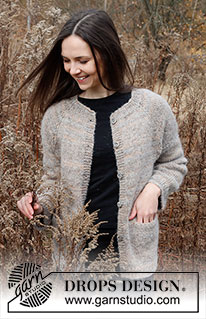
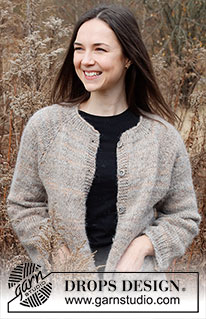
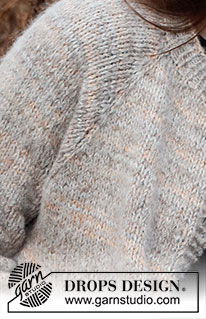









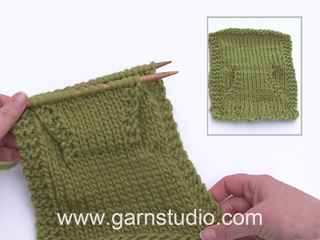





































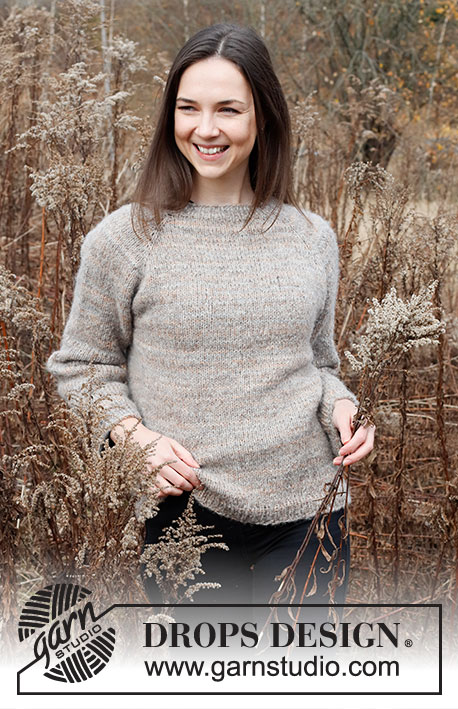






Comments / Questions (13)
Is het de bedoeling dat voor de raglan bij iedere rechtse naald gemeerderd wordt of 1 rechtse naald wel 1 rechtse naald niet?
25.09.2023 - 11:55DROPS Design answered:
Dag Sonja,
Alle raglanmeerderingen worden aan de goede kant gemaakt, dat is inderdaad waar je recht breit en dus niet op de verkeerde kant, waar je averecht breit. Je meerdert dus om de naald voor de raglan (aan de goede kant wel en aan de verkeerde kant niet).
27.09.2023 - 20:30Nybörjarfråga: Ska man räkna med maskorna som sitter på stickan när man mäter? T.ex. vid minskning under ärmarna så spelar det ju verkligen roll. Eller ska man mäta det som redan är färdigstickat under stickan?
08.06.2023 - 11:53DROPS Design answered:
Hej Emelie, räkna med maskorna som sitter på stickan :)
09.06.2023 - 09:38Als je voor dit model een ronding op de achterkant voor de hals wilt breien over hoeveel steken zou je dit dan moeten doen?
16.09.2022 - 09:45DROPS Design answered:
Dag Ria,
Hiervoor zou je even kunnen kijken bij een vest met een vergelijkbaar patroon in dezelfde garendikte. Meestal wordt wel over de hele breedte, van raglanlijn tot raglanlijn een verhoging gebreid.
19.09.2022 - 21:27J\'adore vos modèles Drops.... mais pouvez vous donner les explications avec des aiguilles droites ??? beaucoup d\'entre nous ne savent pas tricoter avec des aiguilles circulaires, hélas... merci pour tout -
08.09.2022 - 16:30DROPS Design answered:
Bonjour Mme Roman et merci. Nous ne sommes malheureusement pas en mesure de pouvoir adapter chacun de nos modèles à chaque demande, toutefois, cette leçon devrait pouvoir vous aider; n'hésitez pas à essayer les aiguilles circulaires, c'est parfois bien plus simple et nombreuses sont celles qui les ont domptées après avoir osé essayer. Bon tricot!
09.09.2022 - 09:18How do I access sound on the videos?
09.08.2022 - 13:20DROPS Design answered:
Dear Mrs Friend, Our videos do not have sound. We are a worldwide company and our videos are watched by people around the world, speaking different languages, many of whom do not understand English. We have therefore written instructions to accompany this video, and there is no sound to disturb while watching. Enjoy!
09.08.2022 - 14:19Hello ash valley jacket a lovely pattern I want to knit could you tell me if aran weight or dk yarn is acceptable?
09.06.2022 - 11:50DROPS Design answered:
Dear Mrs Friend, this jacket is worked with a tension of 15 sts = 10 cm, which is more related to a bulky yarn; find all jackets worked top down with aran yarns here and the ones worked with a dk yarn here. Add more filters to sort the patterns. Happy knitting!
09.06.2022 - 13:26Buongiorno. Nel primo ferro a rovescio a inizio del lavoro si fanno le 5 maglie a legaccio per i bordi davanti? Grazie
27.02.2022 - 08:41DROPS Design answered:
Buonasera Anita, sul 1° ferro dopo l'avvio deve lavorare tutte le maglie a rovescio. Buon lavoro!
27.02.2022 - 21:16I would love to make the Ash valley Jacket. The instructions indicate 2 different yarns. Are they combined so you're knitting with them simultaneously? Thanks very much for your time! Toni ps- Happy New Year!
03.01.2022 - 04:40DROPS Design answered:
Hi Toni, Yes you work with the 2 yarns simultaneously. Happy knitting and happy new year to you too. From the Drops Team.
03.01.2022 - 07:39Jeg mener at garnforbruget er forkert oplyst, jeg har brugt 4 ngl fabel og 5 ngl. alpakka brushed silk til str. L. Målene overholdt. Venligst Ulla Frantsen
26.12.2021 - 13:42Czy mogę zrobić sweterek dwoma nitkami z grupy A, tj. Fabel i Kid-Silk?
07.12.2021 - 18:49DROPS Design answered:
Witaj Marto, gdy zamieniasz włóczkę, najważniejszą sprawą jest to, aby próbka, którą z niej wykonasz, była taka sama jak ta podana dla oryginalnej włóczki we wzorze. W ten sposób wymiary gotowego produktu będą takie same jak na schematycznym rysunku na dole opisu we wzorze. Najłatwiej otrzymasz taką samą próbkę, zastępując oryginalną włóczkę inną włóczką z tej samej Grupy włóczek. Można również przerabiać kilkoma nitkami cieńszej włóczki, które w sumie będą odpowiadać grubszej włóczce i otrzymamy w obydwu przypadkach taką samą próbkę. Zalecamy, aby zawsze wykonywać próbkę. Pozdrawiamy!
08.12.2021 - 08:20